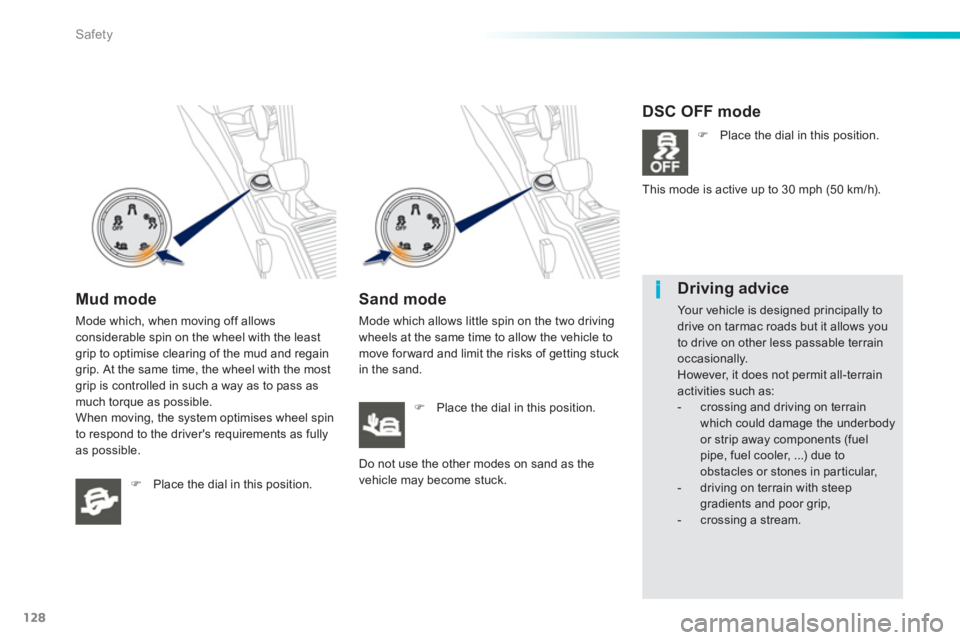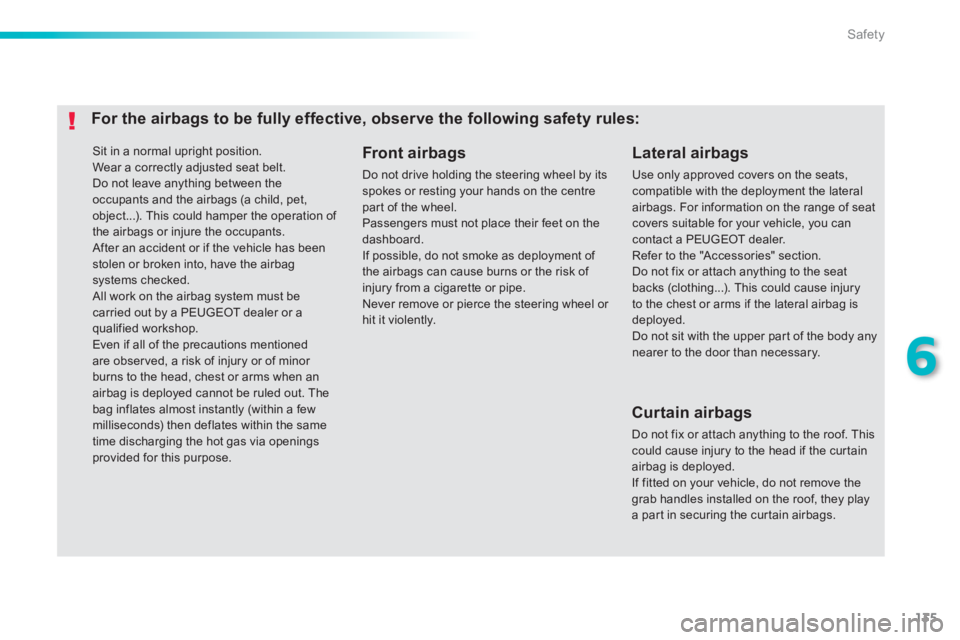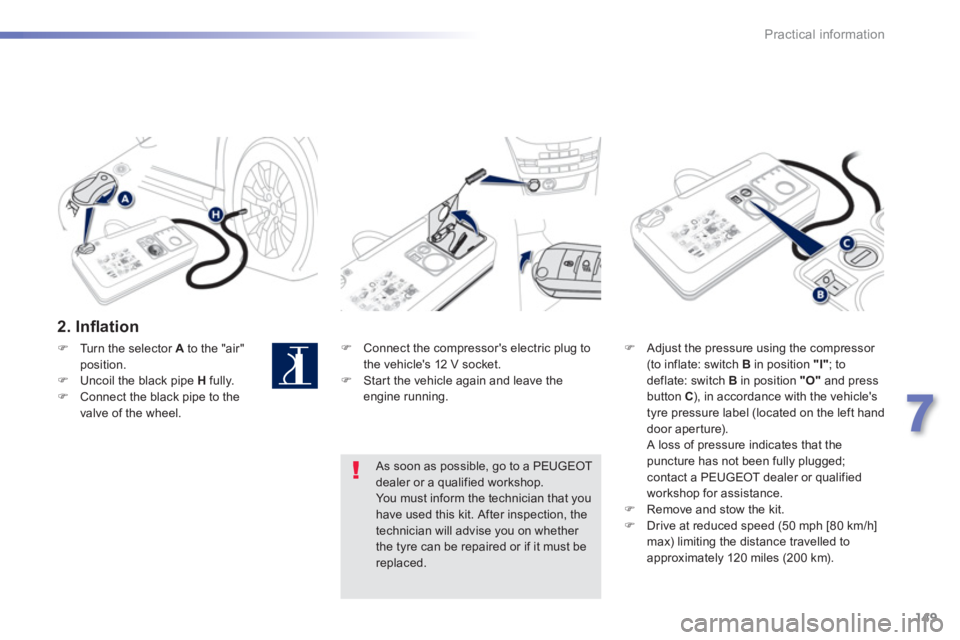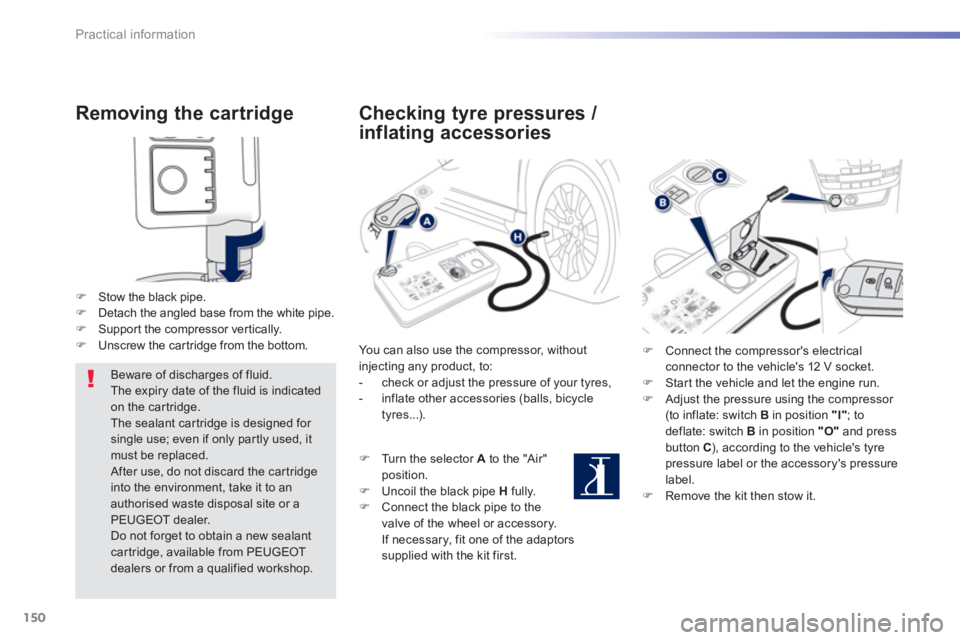Page 130 of 324

128
i
Safety
Mud mode
Mode which, when moving off allowsconsiderable spin on the wheel with the leastgrip to optimise clearing of the mud and regain grip. At the same time, the wheel with the mostgrip is controlled in such a way as to pass as much torque as possible.
When moving, the system optimises wheel spin
to respond to the driver's requirements as
fullyas possible.
�) Place the dial in this position.
Sand mode
Mode which allows little spin on the two drivingwheels at the same time to allow the vehicle tomove for ward and limit the risks of getting stuck
in the sand.
�)Place the dial in this position.
D
o not use the other modes on sand as thevehicle may become stuck.
DSC OFF mode
�)
Place the dial in this position.
This mode is active up to 30 mph
(50 km/h).
Driving advice
Your vehicle is designed principally to drive on tarmac roads but it allows you to drive on other less passable terrainoccasionally.
However, it does not permit all-terrain activities such as:
- crossing and driving on terrainwhich could damage the underbody
or strip away components (fuel pipe, fuel cooler, ...) due toobstacles or stones in particular,
- driving on terrain with steepgradients and poor grip,
- crossing a stream.
Page 134 of 324

132
Safety
Airbags
System designed to maximise the safety of the
occupants (with the exception of the rear centrepassenger) in the event of violent collisions.
The airbags supplement the action of the force-
limiting seat belts (with the exception of the centre rear passenger).
If a collision occurs, the electronic detectors record and analyse the front and side impacts sustained in the impact detection zones:
- in the case of a serious impact, the airbagsare deployed instantly and contribute
towards better protection of the occupants
of the vehicle
(with the exception of the rear centre passenger); immediately after theimpact, the airbags deflate rapidly so that
they do not hinder visibility or the exit of the
occupants,
- in the case of a minor or rear impact
or in cer tain roll-over conditions, the
airbags will not be deployed; the seat belt
alone contributes towards ensuring your protection in these situations.
The airbags do not operate whenthe ignition is switched off.
This equipment will only deploy once.
If a second impact occurs (during thesame or a subsequent accident), theairbag will not be deployed again.
Deployment of the airbag(s) is accompanied by a slight emission of smoke and a noise, due to theactivation of the pyrotechnic cartridgeincorporated in the system.This smoke is not harmful, but sensitiveindividuals may experience slight irritation.
The noise of the detonation may result in a slight loss of hearing for a shorttime.
Impact detection zones
A.
Front impact zone.
B. Side impact zone.
Front airbags
Deployment
The airbags are deployed, except the passenger's
front airbag if it has been deactivated, in the event of
a serious front impact to all or par t of the front impact
z
one A , in the longitudinal centreline of the vehicle on
a horizontal plane and directed from the front to the
rear of the vehicle.
The front airbag inflates between the thorax and head
of the front occupant of the vehicle and the steeringwheel, driver's side, and the dashboard, passenger's
side to cushion their forward movement.
System which protects the driver and frontpassenger in the event of a serious front impact
in order to limit the risk of injury to the head and
thorax.
The driver's airbag is fitted in the centre of the steering wheel; the front passenger's airbag isfitted in the dashboard above the glove box.
Page 137 of 324

135
6
Safety
Sit in a normal upright position.
Wear a correctly adjusted seat belt.
Do not leave anything between theoccupants and the airbags (a child, pet, object...). This could hamper the operation of the airbags or injure the occupants. After an accident or if the vehicle has beenstolen or broken into, have the airbagsystems checked. All work on the airbag system must be carried out by a PEUGEOT dealer or a qualified workshop.
Even if all of the precautions mentionedare obser ved, a risk of injury or of minor burns to the head, chest or arms when an airbag is deployed cannot be ruled out. Thebag inflates almost instantly (within a fewmilliseconds) then deflates within the same
time discharging the hot gas via openings provided for this purpose.
Lateral airbags
Use only approved covers on the seats, compatible with the deployment the lateralairbags. For information on the range of seatcovers suitable for your vehicle, you can contact a PEUGEOT dealer. Refer to the "Accessories" section.Do not fix or attach anything to the seatbacks (clothing...). This could cause injuryto the chest or arms if the lateral airbag isdeployed.Do not sit with the upper par t of the body anynearer to the door than necessary.
Front airbags
Do not drive holding the steering wheel by itsspokes or resting your hands on the centre part of the wheel.
Passengers must not place their feet on thedashboard.
If possible, do not smoke as deployment of the airbags can cause burns or the risk of injury from a cigarette or pipe.
Never remove or pierce the steering wheel or hit it violently.
For the airbags to be fully effective, observe the following safety rules:
Curtain airbags
Do not fix or attach anything to the roof. This could cause injury to the head if the cur tain airbag is deployed. If fitted on your vehicle, do not remove thegrab handles installed on the roof, they play a part in securing the cur tain airbags.
Page 148 of 324
146
Practical information
A. "Sealant" or "Air" position selector.B.On "I"/ off "O"
switch. C.Deflation button.D.
Pressure gauge (in bar or p.s.i.).E.
Compartment housing:
- a cable with adaptor for 12 V socket,
- various inflation adaptors for accessories, such as balls, bicycle
tyres...
Description of the kit
F.
Sealant car tridge.
G.White pipe with cap for repair. H.Black pipe for inflation. I. Speed limit sticker.
The speed limit sticker Imust be affixed to the vehicle's steering wheel to remind you that a wheel is in temporary use.
Do not exceed a speed of 50 mph (80 km/h) when driving with a tyre repaired using this type of kit.
Page 151 of 324

149
7
Practical information
2. Infl ation
�)
Connect the compressor's electric plug to
the vehicle's 12 V socket.�) Star t the vehicle again and leave theengine running.
�)
Adjust the pressure using the compressor (to inflate: switch B
in position "I"
; to deflate: switch B
in position "O"and press button C), in accordance with the vehicle's
tyre pressure label (located on the left hand
door aperture).
A loss of pressure indicates that thepuncture has not been fully plugged; contact a PEUGEOT dealer or qualified
workshop for assistance. �) Remove and stow the kit. �)
Drive at reduced speed (50 mph [80 km/h]max) limiting the distance travelled to
approximately 120 miles (200 km).
As soon as possible, go to a PEUGEOTdealer or a qualified workshop.Yo u m u s t i nform the technician that you have used this kit. After inspection, the technician will advise you on whether the tyre can be repaired or if it must be replaced.
�)Turn the selector A
to the "air" position.�)Uncoil the black pipe Hfully. �)Connect the black pipe to the
valve of the wheel.
Page 152 of 324

150
Practical information
Removing the cartridge
�) Stow the black pipe.�)
Detach the angled base from the white pipe. �)
Suppor t the compressor ver tically.�)
Unscrew the car tridge from the bottom.
Beware of discharges of fluid.
The expiry date of the fluid is indicated on the car tridge.
The sealant car tridge is designed for
single use; even if only partly used, itmust be replaced. After use, do not discard the car tridge into the environment, take it to anauthorised waste disposal site or aPEUGEOT dealer.
Do not forget to obtain a new sealantcartridge, available from PEUGEOT dealers or from a qualified workshop.
Checking tyre pressures /
inflatin
g accessories
You can also use the compressor, without injecting any product, to:
- check or adjust the pressure of your tyres,
- inflate other accessories (balls, bicycle
tyres...).
�)
Turn the selector A
to the "Air"
position.
�) Uncoil the black pipe H
fully.�)
Connect the black pipe to the
valve of the wheel or accessory.
If necessary, fit one of the adaptorssupplied with the kit first.
�)Connect the compressor's electrical connector to the vehicle's 12 V socket.�)Star t the vehicle and let the engine run.�)Adjust the pressure using the compressor (to inflate: switch B in position "I"
; to deflate: switch B
in position "O"and press button C), according to the vehicle's tyrepressure label or the accessory's pressure
label. �)Remove the kit then stow it.
Page 153 of 324
151
7
Practical information
Changing a wheel
The tools are installed in the boot under the floor.
To gain access to them: �)open the boot, �)lift the floor and remove it. �)remove the polystyrene spacer,�)remove the carrier box containing the tools.
Access to the tools
List of tools *
3."Bolt cover" tool.
For removing the bolt protectors
(covers)on alloy wheels.4.Socket for the security bolts (located in theglove box).
For adapting the wheelbrace to the special
"security" bolts.
5.Towing eye.
See "Towing the vehicle".
Procedure for chan
ging a faulty wheel for the spare wheel using the tools provided with the vehicle.
All o
f these tools are specific to your vehicle andcan vary according to the level of equipment. Donot use them for other purposes.
1.Wheelbrace.
For removing the wheel trim and removing
the wheel bolts.
2. Jack with integral handle.For raising the vehicle.
*
Depending on country of sale.
Page 154 of 324
152
Practical information
Wheel with trim
When refitting the wheel
, refit the trimstarting by placing its notch facing thevalve and press around its edge withthe palm of your hand.
The spare wheel is installed in the boot under
th
e floor.
It is the "space-saver" type.
To gain access to it, refer to the paragraph"Access to the tools" on the previous page.
Access to the spare wheel *
Ta k i ng out the wheel
�)Unscrew the yellow central bolt. �)Raise the spare wheel towards you from
the rear.�)Take the wheel out of the boot.
* Dependin
g on country of sale.